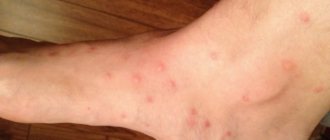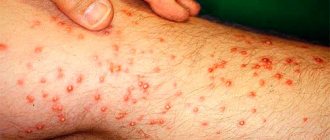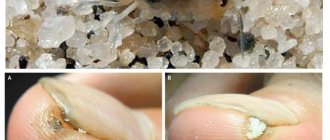What do flea bites look like on a person?
Once on the human body, the flea pierces the skin, injects an enzyme that prevents blood clotting, and then sucks out the blood. Since the saliva of these parasites, unlike others, does not contain an anesthetic, fleas bite painfully; the bite feels like a very thin needle piercing the skin.
Fleas most often live at a height of no more than 1 m, so both on the street and at home they mainly bite people on the legs. A flea bite looks like a small wound, which very soon turns into a dense tubercle against the background of a pink spot. Usually there are several tracks, they are located chaotically, not far from each other.
Flea bites
How to keep children safe?
Flea remedies
Preventive measures will help prevent flea bites in children. The main thing is disinfestation of residential premises. Before you start treating the apartment, you need to destroy parasites on pets. Shampoos, sprays, drops, collars and other means are suitable for this. You can find out which one is suitable for your particular pet from your veterinarian.
Fleas live not only on the body of the owner, but can also hide under baseboards, in carpets, floor crevices, upholstery and even in cribs. The treatment of the premises must be comprehensive. Anyone who is not confident in their own abilities should contact a specialized company. Exterminators use drugs that are poisonous to fleas, but safe for humans and pets. The result is the complete destruction of bloodsuckers and their larvae.
To avoid re-infection, you need to ensure that children and pets do not have contact with stray animals. Cats and dogs should walk in anti-flea collars impregnated with special compounds.
To protect your child from insect attacks outside the home, you can use special ointments or sprays. The content of the active component (DEET) in them should be no more than 5–10%. Children under 3 years of age are a contraindication to the use of repellents.
How dangerous are flea bites?
Fleas pose a danger to human health. In addition to the fact that bites are painful, itch for a long time, cause swelling and irritation on the skin, they can cause severe allergies. There are many complex chemical compounds in flea saliva. When a person is bitten by fleas, these substances enter the bloodstream, causing a reaction from the immune system. Sometimes the immune response can be very strong and be expressed by symptoms such as:
- elevated temperature;
- difficulty breathing, cough;
- swelling of the tongue, larynx;
- tachycardia;
- rash;
- headache.
For allergy sufferers, insect bites can cause angioedema and suffocation.
Due to the fact that fleas are carriers of pathogens of various infections, the bitten person can get sick:
- anthrax;
- plague;
- salmonellosis;
- typhus;
- encephalitis;
- brucellosis;
- hepatitis.
Frequent bites and incessant itching negatively affect the state of the nervous system. The person becomes irritable, sleeps poorly, feels bites even when no one bites him.
What infections can fleas carry?
Parasites feed on the blood of healthy, sick and even dead people and animals. When a flea bites a person, the viruses enter the skin and are carried throughout the body through the blood.
The most dangerous diseases that bloodsucking animals can carry:
- anthrax;
- salmonellosis;
- encephalitis;
- typhus;
- tapeworms;
- fungal infections;
- listeriosis;
- tularemia;
- plague.
The greatest danger is posed by fleas that live on rats. These rodents feed on spoiled foods and dead animals and carry dangerous diseases.
If rats appear in the basement of the house, you need to destroy the rodents and carry out a complete treatment of the room. Companies specializing in disinsection and deratization can best cope with this task.
How to relieve itching and eliminate inflammation?
Pharmacies offer a wide range of remedies for insect bites, including fleas. If medications cannot be used for some reason, you can recall proven traditional medicine recipes.
Pharmacy products
Medicines for flea bites are aimed at reducing itching and pain, relieving inflammation, swelling, and speeding up skin regeneration. The most popular are ointments and gels, but there are also shampoos that help get rid of fleas and treat bites.
Fenistil
When thinking about how to apply flea bites on a person, many will first of all think of Fenistil Gel. This is a broad-spectrum drug. Thanks to the substances included in the drug, it has antihistamine properties, softens pain, relieves itching, reduces irritation and swelling.
Fenistil
After flea bites, the gel is applied in a thin layer to the skin, previously treated with an antiseptic.
Diphenhydramine
Diphenhydramine is often prescribed to treat flea bites. The ointment cools the skin, relieves itching, reduces swelling and irritation. After application, the product is quickly absorbed into the skin without leaving any traces.
Hydrocortisone
Quite often, people who are bitten by fleas resort to hydrocortisone ointment. The main advantage of the drug is that it instantly stops an allergic reaction. In addition, the ointment effectively relieves itching and inflammation. The drug is hormonal, therefore it has a number of contraindications. Among them are age less than 2 years, pregnancy, fungal skin lesions.
Sinaflan
Sinaflan is another effective drug that can be used to lubricate parasite bites. The ointment blocks the allergic reaction, reduces swelling, itching and inflammation.
Before treating flea bites with Sinaflan, you need to make sure there are no contraindications, which include tuberculosis, the presence of malignant neoplasms, age under 1 year, as well as pregnancy and lactation.
Nezulin
The drug contains natural ingredients - plant extracts and oils, so it can be used to treat flea bites even for small children. The product has a bactericidal, antipruritic, decongestant effect. Reduces the manifestations of allergies.
Psilo-balm
Psilo-balm will help effectively treat flea bites. The drug contains diphenhydramine, a substance that blocks histamine receptors, thereby weakening the allergic reaction. The drug cools the skin, quickly relieves swelling and soothes itching.
Bepanten
Effective and safe creams and ointments can be used against flea and other insect bites for children from the first days of life. The active substance of the drug Dexpanthenol has anti-inflammatory, regenerating and moisturizing properties.
Elidel
An effective cream for the treatment of atopic dermatitis and also helps against flea bites. It reduces irritation, inflammation, relieves pain and itching, and prevents the development of allergic dermatitis. The drug is also available in the form of an ointment.
Elidel
Features of application
Before applying medicinal preparations to the skin, you need to thoroughly wash the wounds with soap and water or hydrogen peroxide. This will help both clean the affected area and get rid of the itching from flea bites.
A few more recommendations that will help enhance the effect of treatment:
- Before applying ointment or gel, the skin must be dried;
- if the drug is cooled before application, it will quickly eliminate discomfort at the site of the bite;
- any product must be used strictly following the instructions
If self-treatment does not help, you should consult a doctor who will help you choose an effective drug.
Contraindications and precautions
The main contraindication for the use of external agents is individual intolerance or hypersensitivity to the components of the drug. To make sure there is no allergic reaction, it is advisable to first apply the selected medicine to a small area of skin and wait a little.
Before getting rid of flea bite marks on your body using any means, you need to study the instructions. Contraindications may include pregnancy, breastfeeding, and possible age restrictions.
Folk remedies
There are a large number of folk recipes that effectively help reduce discomfort from insect bites. Their main advantages are naturalness and safety. Before using these products, it is advisable to treat the affected area with an antiseptic.
Juice of medicinal plants
The juice of some plants accelerates regeneration, relieves inflammation and itching. Plantain, calendula, and dandelion have antipruritic properties. Fresh leaves should be crushed or crushed thoroughly so that they release juice, then applied to the bite site.
The leaves of mint, celandine, and basil help both relieve itching and remove fleas - insects cannot stand the smell of plants.
Aloe vera is a houseplant that has proven itself in the treatment of various skin lesions. Aloe juice relieves inflammation and swelling, reduces irritation.
Decoctions
A proven folk remedy such as herbal decoction lotions will help get rid of flea bite marks, relieve inflammation and itching. St. John's wort, chamomile, mint, parsley root, and lavender flowers are considered the most effective. First, cool the broth to room temperature, and then moisten a cotton pad in it and apply it to the bite site.
Chamomile decoction
Tea
Tea is well known for its anti-inflammatory properties. Thanks to the tannin contained in tea leaves, itching and swelling are reduced. A napkin soaked in tea or a used tea bag is applied to the bite site. It doesn’t matter what variety you brew – both black and green tea will cope with the unpleasant consequences of bites.
Ammonia
Ammonia helps relieve swelling from flea bites on the body and reduces itching. A teaspoon of alcohol is diluted in a glass of water, and the resulting solution is wiped over the affected area. You can replace ammonia with baking soda.
First steps if a child has been bitten by fleas
If a child has been bitten by fleas, he will be capricious and restless. Children under 2 years old cannot scratch the bite site, which deprives them of appetite and sleep.
When a child is bitten by fleas, what should be done? To eliminate itching and inflammation, the wounds must be treated immediately.
How can you treat fleas in a child:
- Wash the affected limb, torso, and head under running water and bactericidal soap.
- Treat with any of the following:
- brilliant green;
- alcohol;
- hydrogen peroxide.
- Lubricate:
- anti-inflammatory, decongestant;
- sulfur ointment.
- If possible, isolate the treated area with a gauze bandage.
Medicinal anti-inflammatory, decongestant drugs used to lubricate rashes after a flea bite:
- Boro plus. An ointment based on natural ingredients (turmeric, sandalwood, aloe) has a soothing, wound-healing effect.
- Fenistil. It is used to relieve itching and as an antiallergic agent for urticaria.
- Bepanten. The ointment contains B vitamins and affects skin regeneration.
- Psilo-balm gel based on diphenhydramine has an antiallergic effect.
- Cream-gel Nezulin. A preparation that contains natural ingredients (plant extracts and essential oils) and vitamin B.
With multiple bites, one-time or single, but regular, the children’s immune system may malfunction, which will manifest itself in an acute allergic reaction.
Symptoms of acute allergies:
- temperature increase;
- enlargement of nearby lymph nodes (on the neck, under the armpit, in the groin);
- diarrhea;
- irritability;
- small rashes on the child's body.
If such signs occur, the child should be shown to a doctor to determine the cause.
How long do flea bite marks last?
Skin restoration after flea bites depends on the individual characteristics of the human body. So in children, marks on the skin remain much longer than in adults. This is due to the fact that, firstly, a child’s skin is more delicate, and secondly, it is more difficult for children to resist scratching itchy bites. Bites from allergy sufferers heal much more slowly.
On average, bite marks become invisible after a few days. But this is a very rough forecast. For some, everything heals within a few hours, for others, the bite site is easy to detect even after 2-3 weeks.
What is a house flea?
The external features of these creatures are characteristic of their species of wingless, order of blood-sucking insects. Adults reach up to 5-6 mm in length, and small ones - up to 1-2 mm. In total, they live for about 2 months, however, at the same time, they are able to reproduce very quickly. The body is covered with a kind of chitinous covering, which is almost impossible to crush with your fingers, except perhaps between the nails, pressing down on the individual. They feed exclusively on the blood of humans or domestic animals. Fleas most often live in the following places in a house or apartment:
- in the fur of pets;
- in the carpet;
- soft toys (wherever there is lint);
- can live in waste and garbage;
- as well as in cracks, crevices on the floor or baseboards.
Possible complications
The child's body is very susceptible to flea bites. Therefore, the reaction to their bites can be very diverse. A high temperature rises, diarrhea begins, and an allergic reaction occurs. The most common complication is, of course, a rash on the child’s body. After all, during a bite, a flea injects its enzymes, which cause allergic reactions. The immune system in children is weak and undeveloped and cannot adequately fight back against infection entering the body.
Delicate baby skin is very sensitive. Children do not understand that wounds cannot be scratched, because the infection will spread further. And this causes complications. Therefore, parents are advised to monitor their child more closely. If your body temperature rises even slightly (as a result of a bite from these parasites), you should immediately consult a doctor to prescribe treatment.
First aid for bites
Fleas are carriers of many dangerous diseases. But don’t immediately panic when you discover their bites. You just need to calm down and start acting according to these small instructions:
- First of all, you should wash the wounds with soap (preferably antibacterial). It is better to take cold water, as hot and warm water will only intensify the itching from the bite.
- Disinfect wounds with peroxide, alcohol solution or antiseptic.
- Apply dry ice to the affected area to relieve itching.
- It is better to smear the bite areas with brilliant green or soothing ointment. But home methods are used only in cases where the child, in addition to bites, has no other signs of the disease. Such as fever, nausea, severe rash, etc. In all other cases, you will need to consult a specialist; the doctor will already prescribe antihistamines, antibiotics, soothing and itching ointments.











